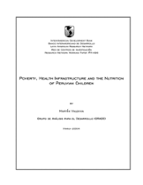Poverty, Health Infrastructure and the Nutrition of Peruvian Children
Date
Mar 2004
This paper discusses the effect of a significant pro-poor expansion of the country's health infrastructure on child nutrition in Peru, as measured by the height-for-age z-score. Using a pooled sample from the 1992, 1996 and 2000 rounds of the Peruvian DHS, this analysis controls for biases in the allocation of public investments by using a district fixed effects model. Desegregating by type of location, the econometric analysis finds that the effect was found to be significant only in urban areas. Furthermore, the effect is highly nonlinear and has a pro-poor bias. In this sense, this policy seems to have had a pro-poor bias within urban areas, while at the same time excluding the rural population, a traditionally marginalized population group in Peru. These findings support the idea that reducing distance and waiting time barriers may be necessary, but that more explicitly inclusive policies are required to improve the health of the rural poor, especially indigenous groups, so that they can escape this kind of poverty trap.



